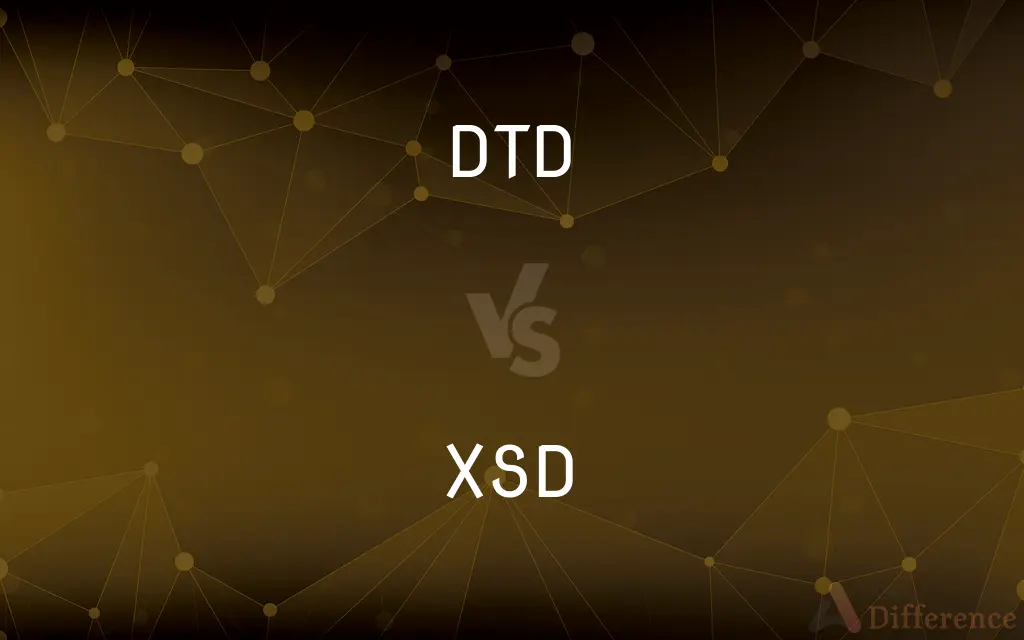DTD vs. XSD — What's the Difference?
By Tayyaba Rehman — Published on January 22, 2024
DTD (Document Type Definition) and XSD (XML Schema Definition) are both used to define the structure and rules for XML documents, but XSD is more powerful and flexible with support for data types and namespaces.

Difference Between DTD and XSD
Table of Contents
ADVERTISEMENT
Key Differences
DTD (Document Type Definition) is a simpler, older method for defining the structure and legal elements of an XML document. It uses a specific syntax to declare the document structure. XSD (XML Schema Definition), on the other hand, is a more recent and robust technology for defining XML document structures and constraints, using XML syntax.
DTD does not support data types for elements and attributes, meaning it can't specify if an element should be a number, string, or date. XSD offers extensive support for data types, including custom data types, providing more control over the content of XML elements and attributes.
In terms of namespaces, DTD lacks the ability to handle XML namespaces, which is a limitation in defining XML documents that utilize namespaces. XSD supports XML namespaces, making it suitable for complex XML applications where namespace management is essential.
DTD is easier to learn and use due to its simplicity but offers limited functionality and control over XML document structures. XSD is more complex but provides greater precision, power, and flexibility for defining XML schemas.
Compatibility and support for DTD are universal in XML parsers, ensuring broad applicability. However, XSD is increasingly favored in modern applications due to its advanced features and capabilities, despite being more complex to implement.
ADVERTISEMENT
Comparison Chart
Syntax
Specific DTD syntax
XML syntax
Data Type Support
No support for data types
Extensive data type support
Namespace Support
No namespace support
Supports XML namespaces
Complexity
Simpler and easier to use
More complex but offers more control
Usage
Suitable for simpler XML structures
Preferred for complex XML applications
Compare with Definitions
DTD
Uses a specific non-XML syntax.
DTD syntax is distinct from the XML it defines.
XSD
Advanced schema definition for XML.
We define precise rules for our XML documents using XSD.
DTD
Lacks data type specification.
In DTD, all elements are treated as character data.
XSD
Offers more control and complexity.
XSD is more complex but necessary for our detailed XML schema.
DTD
Cannot handle XML namespaces.
My XML uses namespaces, so DTD is not suitable.
XSD
Supports custom data types.
In our XSD, we specify that this element must be an integer.
DTD
Defines structure of XML documents.
The DTD specifies which elements are allowed in this XML document.
XSD
Capable of handling namespaces.
Our complex XML documents require XSD for namespace support.
DTD
Simple and widely compatible.
We use DTD for its simplicity in our basic XML applications.
XSD
Uses XML syntax for schemas.
XSD schemas are written in XML, making them more consistent.
Common Curiosities
Is DTD compatible with all XML parsers?
Yes, DTD is universally compatible with XML parsers.
Why would I use DTD over XSD?
DTD is simpler and might be used for basic XML structures or when simplicity is preferred.
Can XSD handle XML namespaces?
Yes, XSD can handle XML namespaces, making it suitable for more complex XML structures.
Can I use DTD for complex XML document structures?
DTD is limited in handling complex structures, especially those requiring data types and namespace support.
Is XSD more complex than DTD?
Yes, XSD is more complex due to its extensive features and capabilities.
What is an XSD?
XSD, or XML Schema Definition, is a more advanced method for defining the structure and constraints of XML documents.
Can XSD define data types for XML elements?
Yes, XSD can define specific data types for XML elements, such as integers, strings, or dates.
What is a DTD?
DTD stands for Document Type Definition, a way to define the structure of XML documents.
Do modern applications prefer DTD or XSD?
Modern applications tend to prefer XSD because of its flexibility and advanced features.
Should beginners start with DTD or XSD for XML?
Beginners might start with DTD for its simplicity, but learning XSD is valuable for dealing with complex XML schemas.
Are there tools to convert DTD to XSD?
Yes, there are tools and software available that can convert DTD schemas to XSD.
Is DTD still relevant today?
While less common in new applications, DTD is still relevant and used in some contexts for its simplicity.
Can XSD validate XML documents more effectively than DTD?
Yes, due to its detailed and precise schema definitions, XSD can validate XML documents more effectively.
Is learning XSD more challenging than DTD?
Yes, due to its complexity and broader range of features, XSD can be more challenging to learn than DTD.
Does XSD support custom data types?
Yes, XSD supports custom data types, allowing for more precise data modeling.
Share Your Discovery

Previous Comparison
Prepaid Plans vs. Postpaid Plans
Next Comparison
Political Science vs. EconomicsAuthor Spotlight
Written by
Tayyaba RehmanTayyaba Rehman is a distinguished writer, currently serving as a primary contributor to askdifference.com. As a researcher in semantics and etymology, Tayyaba's passion for the complexity of languages and their distinctions has found a perfect home on the platform. Tayyaba delves into the intricacies of language, distinguishing between commonly confused words and phrases, thereby providing clarity for readers worldwide.
















































